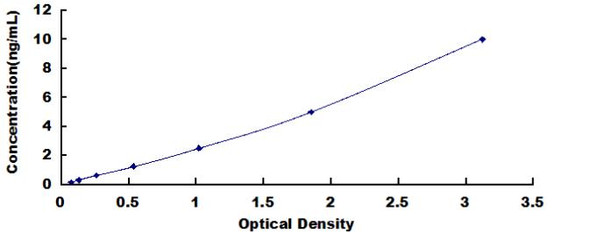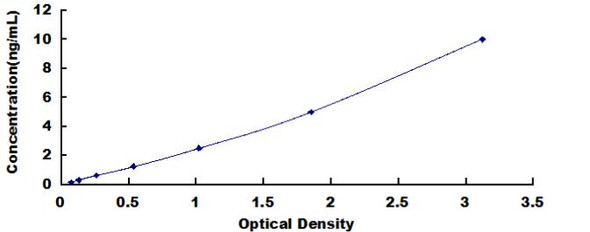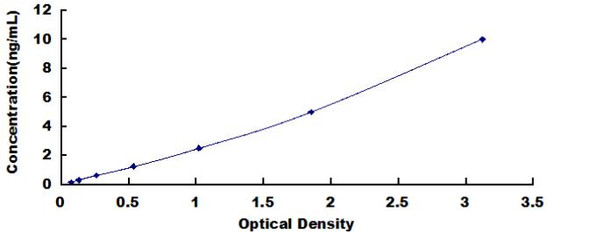Description
Human Nicotinamide phosphoribosyltransferase (NAMPT) ELISA Kit
The Human Nicotinamide Phosphoribosyltransferase (NAMPT) ELISA Kit is a powerful tool for detecting NAMPT levels in human biological samples such as serum, plasma, and cell culture supernatants. With its exceptional sensitivity and specificity, this kit delivers accurate and reproducible results, making it a valuable asset for a wide range of research applications.NAMPT is a key enzyme in the NAD biosynthesis pathway, playing a critical role in regulating cellular metabolism, energy production, and stress response.
Dysregulation of NAMPT has been linked to various diseases including cancer, metabolic disorders, and inflammatory conditions, making it a promising target for therapeutic development and biomarker analysis.Overall, the Human NAMPT ELISA Kit provides researchers with a reliable tool for studying the role of NAMPT in health and disease, paving the way for new insights into potential treatments and diagnostic strategies.
| Product Name: | Human Nicotinamide phosphoribosyltransferase (NAMPT) ELISA Kit |
| SKU: | HUEB0325 |
| Size: | 96T |
| Target: | Human Nicotinamide phosphoribosyltransferase (NAMPT) |
| Synonyms: | Pre-B-cell colony-enhancing factor 1, Visfatin, Pre-B cell-enhancing factor, NAmPRTase, PBEF, PBEF1 |
| Assay Type: | Sandwich |
| Detection Method: | ELISA |
| Reactivity: | Human |
| Detection Range: | 1.56-100ng/mL |
| Sensitivity: | 0.78ng/mL |
| Intra CV: | 4.9% | ||||||||||||||||||||
| Inter CV: | 6.4% | ||||||||||||||||||||
| Linearity: |
| ||||||||||||||||||||
| Recovery: |
| ||||||||||||||||||||
| Function: | Catalyzes the condensation of nicotinamide with 5-phosphoribosyl-1-pyrophosphate to yield nicotinamide mononucleotide, an intermediate in the biosynthesis of NAD. It is the rate limiting component in the mammalian NAD biosynthesis pathway. The secreted form behaves both as a cytokine with immunomodulating properties and an adipokine with anti-diabetic properties, it has no enzymatic activity, partly because of lack of activation by ATP, which has a low level in extracellular space and plasma. Plays a role in the modulation of circadian clock function. NAMPT-dependent oscillatory production of NAD regulates oscillation of clock target gene expression by releasing the core clock component: CLOCK-ARNTL/BMAL1 heterodimer from NAD-dependent SIRT1-mediated suppression (By similarity). |
| Uniprot: | P43490 |
| Sample Type: | Serum, plasma, tissue homogenates, cell culture supernates and other biological fluids |
| Specificity: | Natural and recombinant human Nicotinamide phosphoribosyltransferase |
| Sub Unit: | Homodimer. |
| Research Area: | Immunology |
| Subcellular Location: | Nucleus Cytoplasm Secreted Under non-inflammatory conditions, visfatin predominantly exhibits a granular pattern within the nucleus. Secreted by endothelial cells upon IL-1beta stimulation. Abundantly secreted in milk, reaching 100-fold higher concentrations compared to maternal serum. |
| Storage: | Please see kit components below for exact storage details |
| Note: | For research use only |
| UniProt Protein Function: | PBEF: an ubiquitous protein originally described as a cytokine which acts on early B-lineage precursor cells. Other reports indicate that PBEF is not a cytokine-like secreted protein but an intracellular protein associated with the cell cycle. Contains a catalytically active nicotinate phosphoribosyltransferase domain, an enzyme involved in nicotinamide adenine dinucleotide (NAD) biosynthesis. |
| UniProt Protein Details: | Protein type:Cell cycle regulation; Transferase; EC 2.4.2.12; Cytokine; Cofactor and Vitamin Metabolism - nicotinate and nicotinamide Chromosomal Location of Human Ortholog: 7q22.3 Cellular Component: extracellular space; cytosol; nucleus Molecular Function:protein binding; protein homodimerization activity; cytokine activity; nicotinate-nucleotide diphosphorylase (carboxylating) activity; drug binding; nicotinamide phosphoribosyltransferase activity Biological Process: circadian rhythm; vitamin metabolic process; positive regulation of smooth muscle cell proliferation; female pregnancy; signal transduction; response to organic cyclic substance; NAD biosynthetic process; cell-cell signaling; NAD metabolic process; nicotinamide metabolic process; positive regulation of cell proliferation; insulin receptor signaling pathway; positive regulation of transcription from RNA polymerase II promoter; circadian regulation of gene expression; water-soluble vitamin metabolic process; positive regulation of nitric-oxide synthase biosynthetic process |
| NCBI Summary: | This gene encodes a protein that catalyzes the condensation of nicotinamide with 5-phosphoribosyl-1-pyrophosphate to yield nicotinamide mononucleotide, one step in the biosynthesis of nicotinamide adenine dinucleotide. The protein belongs to the nicotinic acid phosphoribosyltransferase (NAPRTase) family and is thought to be involved in many important biological processes, including metabolism, stress response and aging. This gene has a pseudogene on chromosome 10. [provided by RefSeq, Feb 2011] |
| UniProt Code: | P43490 |
| NCBI GenInfo Identifier: | 1172027 |
| NCBI Gene ID: | 10135 |
| NCBI Accession: | P43490.1 |
| UniProt Related Accession: | P43490 |
| Molecular Weight: | |
| NCBI Full Name: | Nicotinamide phosphoribosyltransferase |
| NCBI Synonym Full Names: | nicotinamide phosphoribosyltransferase |
| NCBI Official Symbol: | NAMPT |
| NCBI Official Synonym Symbols: | VF; PBEF; PBEF1; VISFATIN; 1110035O14Rik |
| NCBI Protein Information: | nicotinamide phosphoribosyltransferase |
| UniProt Protein Name: | Nicotinamide phosphoribosyltransferase |
| UniProt Synonym Protein Names: | Pre-B-cell colony-enhancing factor 1; Pre-B cell-enhancing factor; Visfatin |
| UniProt Gene Name: | NAMPT |
| UniProt Entry Name: | NAMPT_HUMAN |
| Component | Quantity (96 Assays) | Storage |
| ELISA Microplate (Dismountable) | 8×12 strips | -20°C |
| Lyophilized Standard | 2 | -20°C |
| Sample Diluent | 20ml | -20°C |
| Assay Diluent A | 10mL | -20°C |
| Assay Diluent B | 10mL | -20°C |
| Detection Reagent A | 120µL | -20°C |
| Detection Reagent B | 120µL | -20°C |
| Wash Buffer | 30mL | 4°C |
| Substrate | 10mL | 4°C |
| Stop Solution | 10mL | 4°C |
| Plate Sealer | 5 | - |
Other materials and equipment required:
- Microplate reader with 450 nm wavelength filter
- Multichannel Pipette, Pipette, microcentrifuge tubes and disposable pipette tips
- Incubator
- Deionized or distilled water
- Absorbent paper
- Buffer resevoir
*Note: The below protocol is a sample protocol. Protocols are specific to each batch/lot. For the correct instructions please follow the protocol included in your kit.
Allow all reagents to reach room temperature (Please do not dissolve the reagents at 37°C directly). All the reagents should be mixed thoroughly by gently swirling before pipetting. Avoid foaming. Keep appropriate numbers of strips for 1 experiment and remove extra strips from microtiter plate. Removed strips should be resealed and stored at -20°C until the kits expiry date. Prepare all reagents, working standards and samples as directed in the previous sections. Please predict the concentration before assaying. If values for these are not within the range of the standard curve, users must determine the optimal sample dilutions for their experiments. We recommend running all samples in duplicate.
| Step | |
| 1. | Add Sample: Add 100µL of Standard, Blank, or Sample per well. The blank well is added with Sample diluent. Solutions are added to the bottom of micro ELISA plate well, avoid inside wall touching and foaming as possible. Mix it gently. Cover the plate with sealer we provided. Incubate for 120 minutes at 37°C. |
| 2. | Remove the liquid from each well, don't wash. Add 100µL of Detection Reagent A working solution to each well. Cover with the Plate sealer. Gently tap the plate to ensure thorough mixing. Incubate for 1 hour at 37°C. Note: if Detection Reagent A appears cloudy warm to room temperature until solution is uniform. |
| 3. | Aspirate each well and wash, repeating the process three times. Wash by filling each well with Wash Buffer (approximately 400µL) (a squirt bottle, multi-channel pipette,manifold dispenser or automated washer are needed). Complete removal of liquid at each step is essential. After the last wash, completely remove remaining Wash Buffer by aspirating or decanting. Invert the plate and pat it against thick clean absorbent paper. |
| 4. | Add 100µL of Detection Reagent B working solution to each well. Cover with the Plate sealer. Incubate for 60 minutes at 37°C. |
| 5. | Repeat the wash process for five times as conducted in step 3. |
| 6. | Add 90µL of Substrate Solution to each well. Cover with a new Plate sealer and incubate for 10-20 minutes at 37°C. Protect the plate from light. The reaction time can be shortened or extended according to the actual color change, but this should not exceed more than 30 minutes. When apparent gradient appears in standard wells, user should terminatethe reaction. |
| 7. | Add 50µL of Stop Solution to each well. If color change does not appear uniform, gently tap the plate to ensure thorough mixing. |
| 8. | Determine the optical density (OD value) of each well at once, using a micro-plate reader set to 450 nm. User should open the micro-plate reader in advance, preheat the instrument, and set the testing parameters. |
| 9. | After experiment, store all reagents according to the specified storage temperature respectively until their expiry. |
When carrying out an ELISA assay it is important to prepare your samples in order to achieve the best possible results. Below we have a list of procedures for the preparation of samples for different sample types.
| Sample Type | Protocol |
| Serum | If using serum separator tubes, allow samples to clot for 30 minutes at room temperature. Centrifuge for 10 minutes at 1,000x g. Collect the serum fraction and assay promptly or aliquot and store the samples at -80°C. Avoid multiple freeze-thaw cycles. If serum separator tubes are not being used, allow samples to clot overnight at 2-8°C. Centrifuge for 10 minutes at 1,000x g. Remove serum and assay promptly or aliquot and store the samples at -80°C. Avoid multiple freeze-thaw cycles. |
| Plasma | Collect plasma using EDTA or heparin as an anticoagulant. Centrifuge samples at 4°C for 15 mins at 1000 × g within 30 mins of collection. Collect the plasma fraction and assay promptly or aliquot and store the samples at -80°C. Avoid multiple freeze-thaw cycles. Note: Over haemolysed samples are not suitable for use with this kit. |
| Urine & Cerebrospinal Fluid | Collect the urine (mid-stream) in a sterile container, centrifuge for 20 mins at 2000-3000 rpm. Remove supernatant and assay immediately. If any precipitation is detected, repeat the centrifugation step. A similar protocol can be used for cerebrospinal fluid. |
| Cell culture supernatant | Collect the cell culture media by pipette, followed by centrifugation at 4°C for 20 mins at 1500 rpm. Collect the clear supernatant and assay immediately. |
| Cell lysates | Solubilize cells in lysis buffer and allow to sit on ice for 30 minutes. Centrifuge tubes at 14,000 x g for 5 minutes to remove insoluble material. Aliquot the supernatant into a new tube and discard the remaining whole cell extract. Quantify total protein concentration using a total protein assay. Assay immediately or aliquot and store at ≤ -20 °C. |
| Tissue homogenates | The preparation of tissue homogenates will vary depending upon tissue type. Rinse tissue with 1X PBS to remove excess blood & homogenize in 20ml of 1X PBS (including protease inhibitors) and store overnight at ≤ -20°C. Two freeze-thaw cycles are required to break the cell membranes. To further disrupt the cell membranes you can sonicate the samples. Centrifuge homogenates for 5 mins at 5000xg. Remove the supernatant and assay immediately or aliquot and store at -20°C or -80°C. |
| Tissue lysates | Rinse tissue with PBS, cut into 1-2 mm pieces, and homogenize with a tissue homogenizer in PBS. Add an equal volume of RIPA buffer containing protease inhibitors and lyse tissues at room temperature for 30 minutes with gentle agitation. Centrifuge to remove debris. Quantify total protein concentration using a total protein assay. Assay immediately or aliquot and store at ≤ -20 °C. |
| Breast Milk | Collect milk samples and centrifuge at 10,000 x g for 60 min at 4°C. Aliquot the supernatant and assay. For long term use, store samples at -80°C. Minimize freeze/thaw cycles. |









